March 2003
Geoff Huston
If you are involved in the operation of an IP network, a question you may hear is: "How good is your network?" Or, to put it another way, how can you measure and monitor the quality of the service that you are offering to your customers? And how can your customers monitor the quality of the service you provide to them?
These questions have been lurking behind many public and enterprise IP networks for many years now. With the increasing levels of deployment of various forms of high-speed (or broadband) services within today's Internet there is new impetus to find some usable answers that allow both providers and users to place some objective benchmarks against the service offerings. With the lift in access speed with broadband services, there is an associated expectation on the part of the end user or service customer about the performance of the Internet service. It should be "better" in some fashion, where "better" relates to the performance of the network and the service profile that is offered to network applications. And not only is there an expectation of "better" performance, it should be measurable. This article looks at network performance and explores its definition and measurement.
An informal functional approach to a definition of network performance is measuring the speed of the network. How fast is the network? Or, what is the elapsed time for a particular network transaction? Or, how quickly can I download a data file? This measurement of time for a network transaction to complete certainly relates to the speed of the network, and speed is a good network performance benchmark, but is speed everything?
When looking at the broad spectrum of performance, the answer is that speed is not everything. The ability of a network to support transactions that include the transfer of large volumes of data, as well as supporting a large number of simultaneous transactions, is also part of the overall picture of network load and hence of network performance. But large data sets is not everything in performance. Consideration should also be given to the class of network applications where the data is implicitly clocked according to some external clock source. Such real-time applications include interactive voice and video, and their performance requirements include the total delay between the end points, or latency, as well as the small-scale variation of this latency, or jitter. Such performance measurements also include the ratio of discarded packets to the total number of packets sent, or loss rate, as well as the extent to which a sequence of packets is reordered within the network, or even duplicated by the network. Taken together, this set of performance factors can be considered as a form of the amount of distortion of the original real-time signal.
Accordingly, a functional description of network performance encompasses a description of speed, capacity, and distortion of transactions that are carried across the network. This informal description of what constitutes network performance certainly feels to be on the correct path, given that if one knew the latency, available bandwidth, loss, and jitter rates and packet reorder probability as a profile of network performance between two network end points, as well as the characteristics of the network transaction, it is possible to make a reasonable prediction relating to the performance of the transaction.
Taking this informal definition, the next step is to create a more rigorous framework for measuring performance. For any single network path between an entry and egress point, it is possible to measure the path latency, available peak bandwidth, loss rates, jitter profile, and reorder probability. But there is a difference between a description of the performance of a particular path across a network and the performance of the network as an aggregate entity. Given a set of per-path performance measurements, how can you construct a view of the performance of the network? A common methodology is to take a relatively complete set of path measurements across a network and then combine them to create an average metric. Although this accomplishes a useful reduction in the size of the data, there is also a loss of information. The average network performance measurements have little relationship to the performance of any individual path.
There are various ways to improve this loss of information, including weighting the individual path measurements by the amount of traffic passed along the path. Such techniques are indeed to ensure that paths that use far-flung network outliers that carry relatively low volumes of traffic have a much lower impact on the overall network performance metric than the major network transit paths.
Given these performance indicators, the next step is to determine how these indicators may be measured, and how the resulting measurements can be meaningfully interpreted. At this point it is useful to look at numerous popular network management and measurement tools and examine their ability to provide useful measurements. There are two basic approaches to this task; one is to collect management information from the active elements of the network using a management protocol, and from this information make some inferences about network performance. This can be termed a passive approach to performance measurement, in that the approach attempts to measure the performance of the network without disturbing its operation. The second approach is to use an active approach and inject test traffic into the network and measure its performance in some fashion, and relate the performance of the test traffic to the performance of the network in carrying the normal payload.
In IP networks the ubiquitous network management tool is the Simple etwork Management Protocol (SNMP). There is no doubt that SNMP can provide a wealth of data about the operational status of each management network element, but can it tell you anything about the overall network performance?
The operation of SNMP is a polling operation , where a management station directs periodic polls to various managed elements and collects the responses. These responses are used to update a view of the operating status of the network.
The most basic tool for measuring network performance is the periodic measurement of the interface byte counters. Such measurements can provide a picture of the current traffic levels on the network link, and when related to the total capacity of the link, the relative link loading level can be provided. As a performance indicator this relative link loading level can provide some indication of link performance, in that a relatively lightly loaded link (such as a load of 5 to 10 percent of total available capacity) would normally indicate a link that has no significant performance implications, whereas a link operating at 100 percent of total available capacity would likely be experiencing high levels of packet drop, queuing delay, and potentially a high jitter level. (Figure 1) In between these two extremes there are performance implications of increasing the load. Of course it should be noted that the characteristics of the link have a bearing on the interpretation of the load levels, and a low-latency 10-Gbps link operating at 90-percent load will have very significantly lower levels of performance degradation than a 2-Mbps high-latency link under the same 90-percent load. (Figure 2)
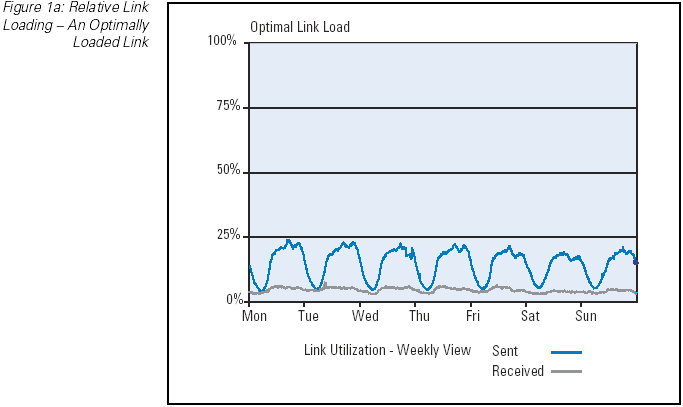
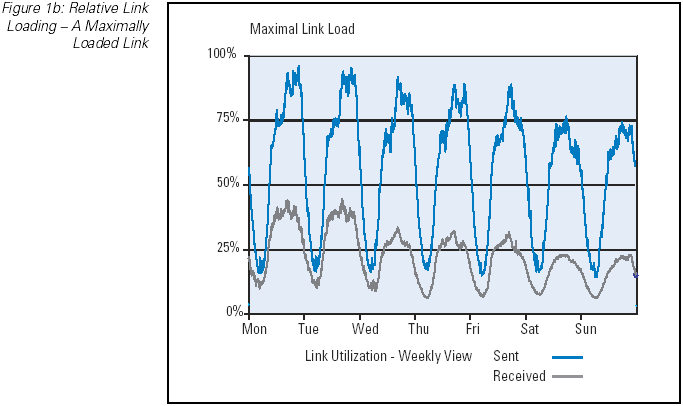
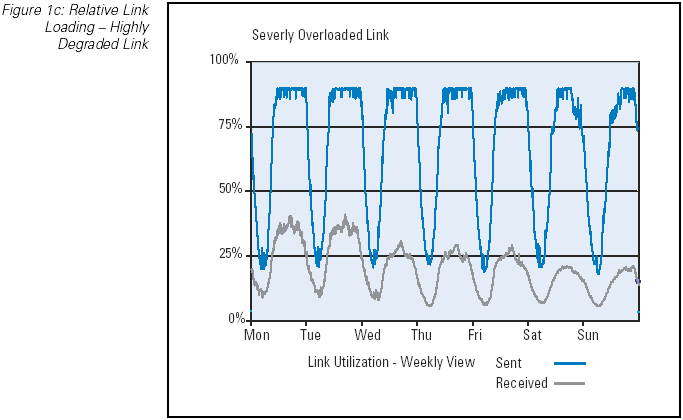
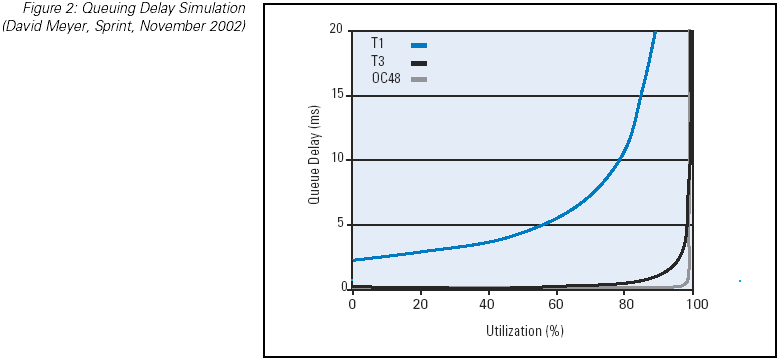
Relative traffic load on each link can be complemented by measurement of performance-related SNMP counters. A management system can poll each active network element to retrieve the number of packets dropped for each interface, and the number of packets successfully forwarded From these two data items, the relative drop proportion of packets can be calculated on an element-by-element and potentially a link-by-link basis, and a series of element measures can provide a per-path drop proportion by combining the individual packet-forwarding measurements for the interfaces on the path.
Bacause some count of relative packet drop rate can be gathered from each network element, with the additional input of the current forwarding state of the network it is possible to predict the path a packet will take through the network, and hence estimate the path probability of drop. However, this information is still well short of being a reliable measurement of service performance.
Queuing delay is somewhat more challenging to measure on an element-by-element basis using element polling with SNMP. In theory, the polling system could use a rapid sequence of polling the output queue length of a router and estimating the queuing delay based on an average packet size estimate, together with the knowledge of the available output capacity. Of course, such a measurement methodology assumes a simple first-in, first-out (FIFO) queuing discipline, a queue size that varies slowly over time, and slow link speeds. Such assumptions are rarely valid in today's IP networks. As the link speed increases, the queue size may oscillate with a relatively high frequency as a function of both the number and capacity of the input systems and of the capacity of the output system. In general, queuing delay is not easily measured using network element polling.
There is no ready way for a polling mechanism to detect and count the incidence of reordered packets. Packet reordering occurs in many situations, including the use of parallel switching fabrics within a single network element and the use of parallel links between routers.
IP routers are not typically designed to detect, let alone correct, packet reordering and because they do not detect this condition, they cannot report on the incidence of reordering via SNMP polling.
The generic approach of network management polling systems is that the polling agent, the network management station, is configured with an internal model of the network; status information, gathered through element polling, is integrated to the network model. The correlation of the status of the model to the status of the network itself is intended to be accurate enough to allow operational anomalies in the network to be recognized and flagged. The challenge is that a sequence of snapshots of element status values cannot readily be reconstructed into a comprehensive view of the performance of the network as an entire system, or even as a collection of edge-to-edge paths. Measurement techniques using polling and modeling can track the performance of the individual elements of the network, but they cannot track per-path service levels across the network. The network-element polling approach can indicate whether or not each network element is operating within the configured operational parameters, and alert the network operator when there are local anomalies to this condition. But such a view is best described as network centric , rather than service centric. An implicit assumption is that if the network is operating within the configured parameters, then all service-level commitments are being met. This assumption may not be well founded.
The complementary approach to performance instrumentation of network elements is active network probing. This requires the injection of marked packets into the data stream; collection of the packets at a later time; and correlation of the entry and exit packets to infer some information regarding delay, drop, and fragmentationconditions for the path traversed by the packet. The most common probe tools in the network today are ping and traceroute.
The best known, and most widely used active measurement tool is ping. Ping is a very simple tool: a sender generates an Internet Control Message Protocol (ICMP) echo request packet, and directs it to a target system. As the packet is sent, the sender starts a timer. The target system simply reverses the ICMP headers and sends the packet back to the sender as an ICMP echo reply. When the packet arrives at the original sender's system, the timer is halted and the elapsed time is reported. An example ping output is shown in Figure 3.

This simple active sampling technique can reveal a wealth of information. A ping response indicates that the target host is connected to the network, is reachable from the query agent, and is in a sufficiently functional state to respond to the ping packet. In itself, this response is useful information, indicating that a functional network path to the target host exists. Failure to respond is not so informative because it cannot be reliably inferred that the target host is not available. The ping packet, or perhaps its response, may have been discarded within the network because of transient congestion, or the network may not have a path to the target host, or the network may not have a path back to the ping sending host, or there may be some form of firewall in the end-to-end path that blocks the ICMP packet from being delivered.
However, if you can ping a remote IP address, then you can obtain numerous performance metrics. Beyond simple reachability, further information can be inferred by the ping approach with some basic extensions to our simple ping model. If a sequence of labeled ping packets is generated, the elapsed time for a response to be received for each packet can be recorded, along with the count of dropped packets, duplicated packets, and packets that have been reordered by the network. Careful interpretation of the response times and their variance can provide an indication of the load being experienced on the network path between the query agent and the target. Load will manifest a condition of increased delay and increased variance, due to the interaction of the router buffers with the traffic flows along the path elements as load increases. When a router buffer overflows, the router is forced to discard packets; and under such conditions, increased ping loss is observed. In addition to indications of network load, high erratic delay and loss within a sequence of ping packets may be symptomatic of routing instability with the network path oscillating between many path states.
A typical use of ping is to regularly test numerous paths to establish a baseline of path metrics. This enables a comparison of a specific ping result to these base metrics to give an indication of current path load within the network.
Of course, it is possible to interpret too much from ping results, particularly when pinging routers within a network. Many router architectures use fast switching paths for data packets, whereas the central processing unit of the router may be used to process ping requests. The ping response process may be given a low scheduling priority because router operations represent a more critical router function. It is possible that extended delays and loss, as reported by a ping test, may be related to the processor load or scheduling algorithm of the target router processor rather than to the condition of the network path. (Figure 4)

Ping sequences do not necessarily mimic packet flow behavior of applications. Typical TCP flow behavior is prone to cluster into bursts of packet transmissions on each epoch of the round-trip time. Routers may optimize their cache management, switching behavior, and queue management to take advantage of this behavior. Ping packets may not be clustered; instead, an evenly spaced pacing is used, meaning that the observed metrics of a sequence of ping packets may not exercise such router optimizations. Accordingly, the ping results may not necessarily reflect an anticipation of application performance along the same path. Also a ping test does not measure a simple path between two points. The ping test measures the time to send a packet to a target system and for the target to respond back to the sender. Ping is measuring a loop rather than a simple path.
With these caveats in mind, monitoring a network through regular ping tests along the major network paths can yield useful information regarding the status of the network service performance.
Many refinements to ping can extend its utility. Ping can use loose source routing to test the reachability of one host to another, directing the packet from the query host to the loose source routed host, then to the target host and back via the same path through the specified approach. However, many networks disable support for loose source routing, given that it can be exploited in some forms of security attacks. Consequently, the failure of a loose source routed ping may not be a conclusive indication of a network fault.
Ping also can be used in a rudimentary way to discover the provisioned capacity of network links. By varying the packet length and comparing the ping times of one router to the next-hop router on a path, the bandwidth of the link can be deduced with some degree of approximation required because of a background queue-induced level of network jitter.
A more sophisticated variation of pingis to pace the transmission of packets from the received packets, mimicking the behavior of the TCP flow control algorithms with Slow Start and subsequent congestion avoidance. Treno is such a tool. In Treno, the transmission of ping packets is managed by the TCP Reno flow-control algorithm, such that further ping packets are triggered by the reception of responses to earlier packets, and the triggering of further packets is managed by an implementation of the TCP control function. Such a tool can indicate available flow rate-managed capacity on a chosen path.
The second common ICMP-based network management tool, traceroute , devised by Van Jacobson, is based on the ICMP Time Exceeded message . Here, a sequence of User Datagram Protocol (UDP) packets are generated to he target host, each with an increased value of the Time To Live (TTL) field in the IP header. This generates a sequence of ICMP Time Exceeded messages sourced from the router where the TTL expired. These source addresses are those of the routers, in turn, on the path from the source to the destination. (Figure 5)

Like ping, traceroute measures the elapsed time between the packet transmission and the reception of the corresponding ICMP packet. In this way, the complete output of a traceroute execution exposes not only the elements of the path to the destination, but also the delay and loss characteristics of each partial path element. Traceroute also can be used with loose source route options to uncover the path between two remote hosts. The same caveats mentioned in the ping description relating to the relative paucity in deployment of support for loose source routing apply. An example of a traceroute report is shown in Figure 6.
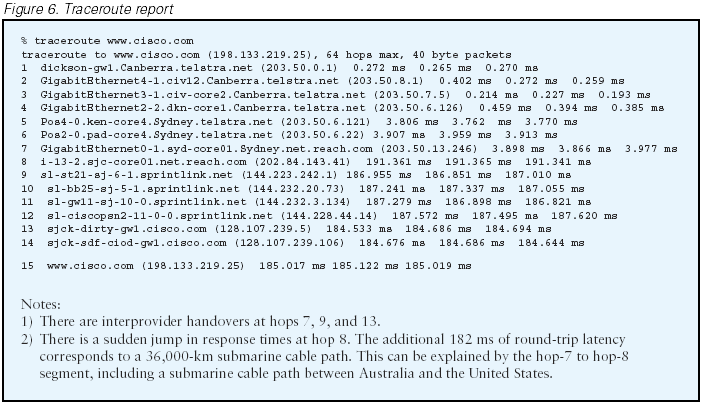
Traceroute is an excellent tool for reporting on the state of the routing system. It operates as an excellent "sanity check" of the match between the design intent of the routing system and the operational behavior of the network.
The caveat to keep in mind when interpreting traceroute output has to do with asymmetric routes within the network. Whereas the per-hop responses expose the routing path taken in the forward direction to the target host, the delay and loss metrics are measured across the forward and reverse paths for each step in the forward path. The reverse path is not explicitly visible to traceroute.
Round-trip probes, such as ping and traceroute, are suited to measuring the total network path between two ends of a transaction, but how can a network provider measure the characteristics of a component of the total end-to-end path? In such a case the network provider is interested in the performance of a set of unidirectional transit paths from an network ingress point to an egress point. There are now some techniques that perform a one-way delay and loss measurement, and they are suited to measuring the service parameters of individual transit paths across a network. A one-way approach does not use a single network management system, but relies on the deployment of probe senders and receivers using synchronized clocks.
The one-way methodology is relatively straightforward. The sender records the precise time a certain bit of the probe packet was transmitted into the network; the receiver records the precise time that same bit arrived at the receiver. Precisely synchronizing the clocks of the two systems is an interesting problem, and initial implementations of this approach have used Global Positioning System (GPS) satellite receivers as a synchronized clock source.
One of the noted problems with the use of GPS was that computers are generally located within machine rooms and a clear GPS signal is normally available only on a rooftop. Later implementations of this approach have used the clock associated with the Code Division Multiple Access (CDMA) mobile telephone network as a highly accurate, synchronized, distributed clock source, with the advantage that the time signal is usually available close to the measurement unit.
Consequent correlation of the sender's and receiver's data from repeated probes can reveal the one-way delay and loss patterns between sender and receiver. To correlate this to a service level requires the packets to travel along the same path as the service flow and with the same scheduling response from the network.
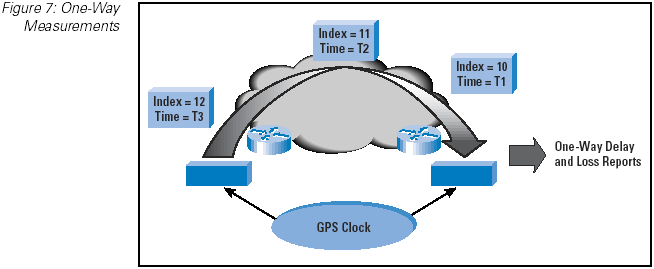
Ping and traceroute are ubiquitous tools. Almost every device can support sending ping and traceroute probes, and, by default almost every device, including network routers, will respond to a ping or traceroute probe. One-way measurements are a different matter, and such measurements normally require the use of dedicated devices in order to undertake the clocking of the probes with the required level of precision (Figure 7).
Whether it is an active or passive measurement regime, the next basic decision is the time base to use for the measurements. Many applications are very sensitive to short-lived transient network conditions. This may take the form of a burst of packet loss, or a period of packet reordering, or a switch to a longer round trip time. TCP may react by halving its sending rate, or by entering an extended wait state while awaiting the retransmission timer to expire. In either case it will take numerous round trip time intervals for the transport session to recover, and this may impact the behavior of the application. On the other hand, a periodic network probe may miss the transient event altogether and report no abnormalities whatsoever.
IP networks have bursty traffic sources, and there is a marked selfsimilarity in the traffic patterns. This appears to be consistent over a wide range of networks, where large-capacity systems tend to observe large burst patterns and smaller systems also see bursts of a similar proportionate size. So the question is, what time interval for measurements can provide meaningful aggregation of information, while at the same time be sensitive enough to report on the outcomes of transient bursts within the network? Intuitively a measurement time base of hourly measurements is very insensitive to capturing transient bursts, whereas a time base of a millisecond would generate a massive amount of data, a scenario that would tend to smother the identification of abnormalities. Interestingly enough, the choice of a measurement base has little to do with the capacity of the links within a network, but it has a close relationship to the average routing trip time of the individual transport sessions that are active within the network.
The profile of IP networks is one that is dominated by TCP traffic, and TCP traffic uses a transport control mechanism where the returning stream of acknowledgement (ACK) packets governs the actions of the sender. This implies that network-based distortion in the forward data path will not be signaled back to the sender for one complete round-trip time interval, and the consequent adaptation of the sender to the conditions of the network will take numerous additional round-trip times. The implication is that in order to capture a comprehensive view of network performance, a time base of 1 to 2 seconds is appropriate. However, for large networks, such a view generates a massive amount of data. It appears that many networks use a measurement time base of about 60 to 300 seconds, representing an acceptable compromise between sensitivity of the measurement system and the consequent volume of measurement data to analyze.
So far the assumption has been that the network operates with a single service level and that probes of the network operate at the same service level as the network payload. This is certainly a common situation, but the total picture is slightly broader. When the network provider attempts to create a premium response for certain classes of traffic, and where the customer is paying a premium tariff to use such a premium service, the question of performance becomes a matter of deep concern to both the provider and the customer. After all, the customer is now paying a premium for improved performance, so it would help all concerned if this could be clearly defined and measured.
Solutions exist in both the passiveand active polling domains. In the case of SNMP there is a monitoring framework (or Management Information Base, MIB) relating to the Differentiated Services (DiffServ) model of Quality of Service (QoS), and also MIBs relating to the Integrated Services (IntServ) QoS model. For the DiffServ MIB, it is first necessary to define an abstract model of the operation of a DiffServ admission router, by looking at the major functional blocks of the router. The first of these blocks is the definition of the supported behavior aggregates provided by the network. Within the network path, the initial active path element is the traffic classification module, which can be modeled as a set of filters and an associated set of output streams. The output stream is passed to the traffic-conditioning elements, which are the traffic meters and the associated action elements. Many meter profiles can be used in the model: an average data rate, an exponential weighted moving average of one of numerous various traffic profiles that can be expressed by a set of token-bucket parameters using an average rate, a peak rate, and a burst size. More elaborate meter specifications can be constructed using a multilevel token-bucket specification. From the meter, the traffic is passed through an action filter, which may mark the packets and shape the traffic profile through queues or discard operations. Together, this sequence of components forms a traffic conditioning block . The traffic is then passed into a queue through the use of a queuing discipline that applies the desired service behavior. (Figure 8)
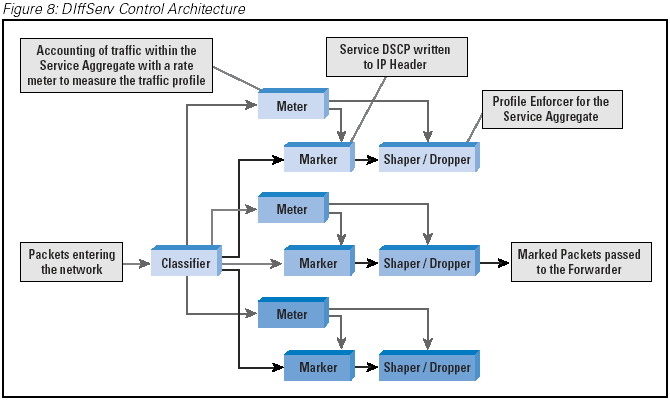
From this generic model it is possible to define instrumentation for SNMP polling, where each of these five components—the behavior aggregate, the classifier, the meter, profile actions, and the queuing discipline—correspond to a MIB table. With this structure it is possible to parameterize both the specific configuration of the DiffServ network element and its dynamic state. This MIB is intended to describe the configuration and operation of both edge and interior DiffServ network elements, the difference being that interior elements use just a behavior aggregate classifier and a queue manager within the management model, whereas the edge elements use all components of the model.
A comparable MIB is defined for the IntServ architecture and an additional MIB for the operation of guaranteed services. The IntServ MIB defines the per-element reservation table used to determine the current reservation state, an indication of whether or not the router can accept further flow reservations, and the reservation characteristics of each current flow. No performance polling parameters or accounting parameters are included in the MIB. The guaranteed services MIB adds to this definition with a per-interface definition of a backlog. This is a means of expressing packet quantization delay , a delay term, which is the packet propagation delay over the interface, and a slack term, which is the amount of slack in the reservation that can be used without redefining the reservation. Again, these are per-element status definitions, and they do not include performance or accounting data items.
The IntServ MIB is being further defined as a esource Reservation Protocol (RSVP) MIB for the operation of IntServ network elements [14]. There are a larger number of objects within the MIB, including General Objects, Session Statistics Table, Session Sender Table, Reservation Requests Received Table, Reservation Requests Forwarded Table, RSVP Interface Attributes Table, and an RSVP Neighbor Table.
Interestingly, the MIB proposes a writeable RSVP reservation table to allow the network manager to manually create a reservation state that can be removed only through a comparable manual operation. The MIB enables a management system to poll the IntServ network element to retrieve the status of every active IntServ reserved flow and the operational characteristics of the flow, as seen by the network element.
In a QoS DiffServ environment, ping and traceroute pose some interesting engineering issues. Ping sends an ICMP packet. The network QoS admission filters may choose a different classification for these packets from that chosen for normal data-flow TCP or UDP protocol packets; as a result, the probe packet may be scheduled differently or even take a completely different path to the network. In an IntServ QoS network, the common classification condition for a flow is a combination of the IP header source and destination addresses and the TCP or UDP header source and destination port addresses. The ping probe packet cannot reproduce this complete flow description, and therefore cannot, by default, be inserted into the flow path that it is attempting to measure. With traceroute, the packet does have a UDP protocol address, but it uses a constant port address by default, causing a similar problem of attempting to be inserted to an IntServ flow. DiffServ encounters similar problems when attempting to pass the probe packet into the network via the DiffServ admission classification systems. Inside the network, it is possible to insert the probe packet into the network with the IP Differentiated Services Code Point (DSCP) field set to the DiffServ behavior aggregate that is being measured.
The measurement of delay and loss taken by ping and traceroute is a cumulative value of both the forward and return path delay and loss. When attempting to measure unidirectional flow-path behavior, such as an IntServ flow path, this measurement is of dubious value, given the level of uncertainty as to which part of the path, forward or reverse, contributed to the ping or traceroute delay and loss reports.
For one-way delay measurements, in DiffServ networks, this can be done within the network, setting the DSCP field to the value of the service aggregate being monitored. Of course, from the customer's perspective, the DiffServ network service profile includes the admission traffic-conditioning block, and the interior one-way measurements are only part of the delivered service. In the IntServ network, the packets have to be structured to take the same path as the elevated service flows; they are classified by each element as part of the collection of such elevated service flows for the purposes of scheduling.
From the client's perspective, the measurement choices are more limited. A client does not normally enjoy the ability to poll network elements within a provider's network. One way for a client to measure service quality is to instigate probing of the network path, whereby a sender can pass a probe packet into the network and measure the characteristics of the response. Of course, the problems of inserting probe packets into the service flow remain, as do the issues of unidirectional elevated service flows with bidirectional probes.
However, the client does have the advantage of being able to monitor and manipulate the characteristics of the service flow itself. For TCP sessions, the client can monitor the packet retransmission rate, the maximum burst capacity, the average throughput, the round-trip time (RTT), RTT variance, and misordered packets, by monitoring the state of the outbound data flow and relating it to the inbound ACK flow. For UDP sessions, there is no corresponding transport-level feedback information flow to the sender as a part of the transport protocol itself. The receiver can measure the service quality of the received datastream using information provided in the Real-Time Protocol (RTP) information feedback fields—if RTP is being used for real-time data or as an application-related tool for other application types. If sender and receiver work in concert, the receiver can generate periodic quality reports and pass these summaries back to the sender. Such applications can confirm whether an application is receiving a specified level of service. This approach treats the network like a black box; no attempt is made to identify the precise nature or source of events that disrupt the delivered service quality. There are no standardized approaches to this activity, but numerous analysis tools are available for host platforms that perform these measurements.
Though the client can measure and conform service quality on a perapplication level of granularity, the second part of the client's motivation in measuring service quality is more difficult to address. The basic question is whether the service delivered in response to a premium service request is sufficiently differentiated from a best-effort service transaction. Without necessarily conducting the transaction a second time, the best approach is to use either one-way delay probes, for unidirectional traffic, or a bulk TCP capacity probe, to establish some indication of the relativity in performance. From a client perspective none of these are simple to set up, and the dilemma that the customer often faces is the basic question of whether the cost of operating the measurement setup is adequately offset by the value of the resulting answers.
So far we have been looking at the ways of measuring network performance as a general task. Of course degraded performance does not happen by accident (well, sometimes accidents do happen), and it makes the measurement task easier if you can identify precisely what it is that you are looking for. This approach requires identification of the various situations that can impact network performance and then set up network measurement and monitoring systems that are tuned to identify these situations.
Within this approach, the motives for network measurement are concerned with identification of traffic load patterns that cause uneven network load, monitoring, and verification of service-level agreements, detection of abnormal network load that may be a signature of an attack, forecasting and capacity planning, and routing stability.
The objective here is to create a stable and well-understood model of the operational characteristics of the network, and then analyze the situations that could disrupt this stable state and the implications in terms of delivered performance under such conditions.
Such an approach could be described in terms of opposites—instead of measuring network performance, the approach is measuring the network to identify the conditions that cause nonperformance at particular times within particular network paths. As a performance management technique, this approach has been very effective—rather than taking a larger amount of performance data and merging and averaging it into a relatively meaningless index, the approach is to isolate those circumstances where performance is compromised and report on these exceptions rather than on the remainder of the time.
Of course measuring what is "normal" may involve more than assembling a benchmark set of SNMP-derived polling data and a collection of latency, loss, and jitter profiles obtained from analysis of large volumes of ping data. One additional tool is the router itself. Because the router uses many IP packet header fields to switch each packet, one approach is to get the router to assemble and aggregate information about the characteristics of traffic that has been passed through the router, and send these aggregated reports to a network management station for further analysis. NetFlow is the most common tool to undertake this form of reporting. Like SNMP, NetFlow can report on the characteristics of traffic as it passes a point in the network. For measuring end-to-end performance of individual applications, NetFlow has the same limitations as SNMP. The analogy is one of standing on a street corner counting cars that go past and from that measurement attempting to derive the average time for a commuter to drive to or from work. However, the value of NetFlow is that in this context of performance measurement, it can be used to derive a picture of the baseline characteristics of the network, including identification of the endpoints of the traffic flows. Extending the car analogy further, NetFlow can provide an indication of the origins and ultimate destinations of the cars as they pass the monitoring point. This information is useful in terms of designing networks that are adequately configured to handle the transit traffic load. In addition, with careful analysis, NetFlow can be used to identify exceptional traffic conditions. The advantage here is that NetFlow data can be used to identify both the abnormal traffic load and also provide some indication of the endpoints of the abnormal flows. In this way, NetFlow can be deployed as both a baseline network traffic profile benchmarking tool and a performance exception diagnosis tool.
This approach of capturing the packet header information as the traffic passes a monitoring point in the network has been implemented in numerous ways, and NetFlow is not the only data-collection tool in this space. One interesting approach has been used by NeTraMet, an implementation of the Internet Engineering Task Force's (IETF's) Realtime Traffic Flow Measurement architecture for traffic flow measurement.
The feature here is a powerful ruleset within the tool that allows the flow collector to be configured to collect information about particular traffic flows and their characteristics. In the context of measuring performance, one of the abilities of the tool is to match the outbound data flow with the inbound acknowledgement stream, allowing an analyzer some ability to infer end-to-end performance of the application based on the collected information.
It is clear that the picture is so far very incomplete. The active probe measurements require either some latitude of interpretation or dedicated instrumentation to take measurements with some necessary level of frequency and precision. The passive approach of probing the active switching elements of the network is constrained by a very basic model of the switching system, so that the collectable values provide only a very indirect relationship to the manner in which the switching element is generating queuing delays and traffic flow instability.
Perhaps what is also increasingly unclear is the relationship between performance and networks in any case. The last few years have seen a massive swing in public Internet platforms away from networks where some level of congestion and contention was anticipated to networks that are extensively overprovisioned, and there packet jitter and loss are simply not encountered. With the ever-decreasing cost of transmission bandwidth in many markets, this environment of abundant network capacity is now also finding its way into various enterprise network sectors. In such worlds of abundant supply and overengineering of networks, there is really little left to measure within the network. The entire question of performance then becomes a question phrased much closer to home: how well is your system tuned to make the most of its resources and those of the server? Often the entire issue with performance is a situation of abundant network resources, abundant local memory and processing resources, and poor tuning of the transport protocol stack. That is, of course, quite properly the subject of another article.
The Internet offers a wealth of material on the topic of network measurement, and the major exercise is undertaking some filtering to get a broad collection of material that encompasses a range of perspectives on this topic. The following sources were used to prepare this article, and are recommended as starting points for further exploration of this topic.
| [1] | Internet Performance Survival Guide, Geoff Huston, Wiley Computer Publishing, 2000. |
| [2] | "IPPM Metrics for Measuring Connectivity," J. Mahdavi, V. Paxson, RFC 2678, September 1999. |
| [3] | "A One-way Delay Metric for IPPM," G. Almes, S. Kalidinki, M. Zeukuaskas, RFC 2679, September 1999. |
| [4] | "A One-way Packet Loss Metric for IPPM," G. Almes, S. Kalidinki, M. Zeukuaskas, RFC 2680, September 1999. |
| [5] | The RIPE Test Traffic Measurement service at: http://www.ripe.net/ripencc/mem-services/ttm/ |
| [6] | Treno, online at: http://www.psc.edu/networking/treno_info.html |
| [7] | "Trends in Measurement and Monitoring of Internet Backbones," session at the 26th North American Network Operators Group, hosted by D. Meyer, http://www.nanog.org/mtg-0210/measurement.html, October 2002. |
| [8] | "Some thoughts on CoS and Backbone Networks," D. Meyer, presentation to the IEPREP Working Group, IETF-55, http://www.maoz.com/~dmm/IETF55/ieprep/, November 2002. |
| [9] | NetFlow resource page: http://www.cisco.com/warp/public/732/Tech/nmp/netflow/netflow_techdoc.shtml |
| [10] | Netramet, and many other interesting measurement tools are referenced in a resource page at: http://www.caida.org/tools |
| This area of research is active, and numerous activities are ongoing in the area of research group activities and workshops. | |
| [11] | The Internet Research Task Force has an Internet Measurement Research Group. Further details can be found at: http://www.irtf.org/charters/imrg.html |
| [12] | ACM SIGCOMM, the ACM Special Interest Group on Data Communications, sponsors an Internet Measurement Workshop. Proceeding of the November 2002 workshop can be found at: http://www.acm.org/sigcomm/imw2002/ |
| [13] | The details of the 2003 Passive and Active Measurement Workshop can be found at: http://www.pam2003.org |
| [14] | "RSVP Management Information Base using SMIv2," F. Baker, J. Krawczyk, A. Sastry, RFC 2206, September 1997. |